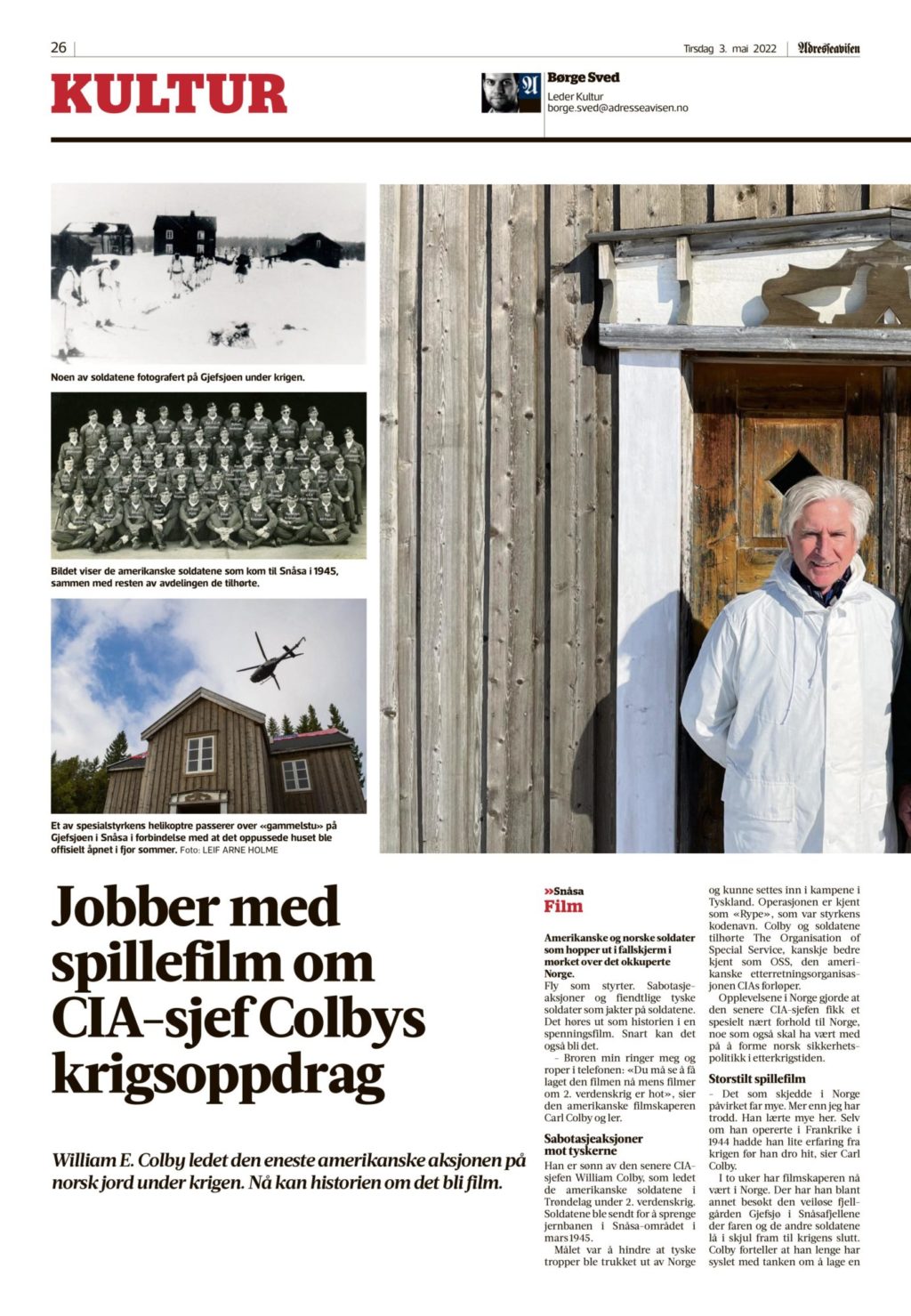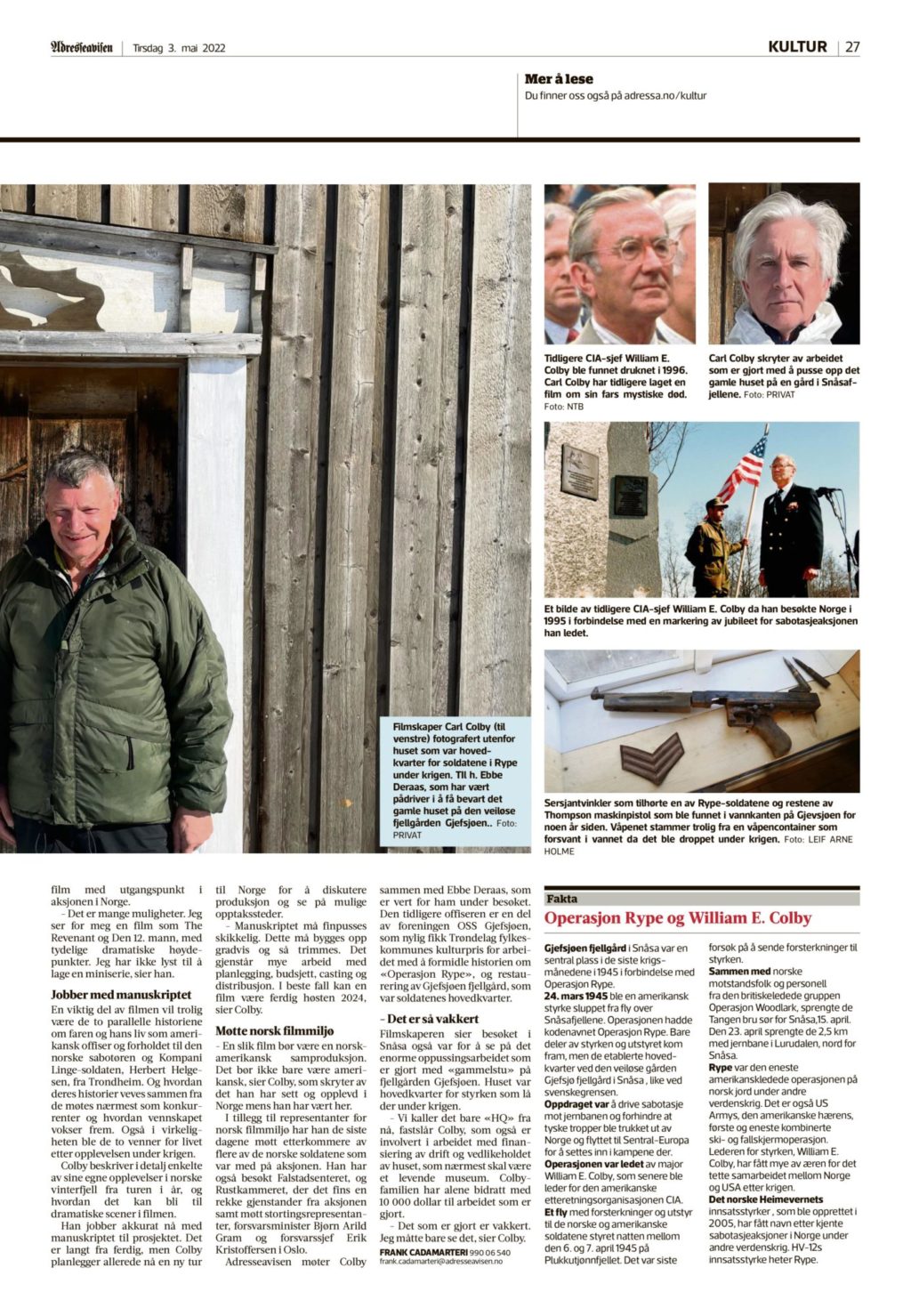William E. Colby led the only American operation on Norwegian soil during the war. Now the story of it can become a movie.
Article by Frank Cadamarteri, Adresseavisen (Translated from Norwegian)
American and Norwegian soldiers parachuting into the darkness over occupied Norway. Aircraft that crashed. Sabotage actions and enemy German soldiers chasing the soldiers. It sounds like the story of a thriller. Soon it can be too. – My brother called me and shouts on the phone: “You have to see that film made now while films about World War II are hot”, says the American filmmaker Carl Colby and laughs.
Sabotage against the Germans
He is the son of the later CIA chief William Colby, who led the American soldiers in Trøndelag during World War II. The soldiers were sent to blow up the railway in the Snåsa area in March 1945. The aim was to prevent German troops from being withdrawn from Norway and being deployed in the fighting in Germany. The operation is known as “Rype” (Grouse), which was the force’s code name. Colby and the soldiers belonged to The Organization of Special Service, perhaps better known as OSS, the forerunner of the CIA. The experiences in Norway meant that the later CIA chief had a particularly close relationship with Norway, which is also said to have helped shape Norwegian security policy in the post-war period.
Large-scale feature film
– What happened in Norway affected father a lot. More than I thought. He learned a lot here. Although he operated in France in 1944, he had little experience from the war before he went here, says Carl Colby. The filmmaker has now been in Norway for two weeks. There he has, among other things, visited the roadless mountain farm Gjefsjø in Snåsafjellene where his father and the other soldiers lay in hiding until the end of the war. Colby says that he has long been involved in the idea of making a film based on the action in Norway. – There are many possibilities. I envision a film like The Revenant and The 12th Man, with clear dramatic highlights. I do not want to make a miniseries, he says.
Working on the script
An important part of the film will probably be the two parallel stories about his father and his life as an American officer and his relationship with the Norwegian saboteur and Kompani Linge soldier, Herbert Helgesen, from Trondheim. And how their stories are woven together from the closest they meet as competitors and how the friendship grows. Also in reality, the two became friends for life after the experience during the war. Colby describes in detail some of his own experiences in Norwegian winter mountains from the trip this year, and how it can turn into dramatic scenes in the film. He is currently working on the script for the project. It is far from finished, but Colby is already planning a new trip to Norway to discuss production and look at possible filming locations. – The manuscript must be refined properly. This must be built up gradually and then trimmed. There is still a lot of work to do with planning, budgeting, casting and distribution. At best, a film can be finished in the autumn of 2024, says Colby.
Met the Norwegian film community
– Such a film should be a Norwegian-American co-production. It should not just be American, says Colby, who brags about what he has seen and experienced in Norway while he has been here. In addition to representatives of the Norwegian film community, he has in recent days met descendants of several of the Norwegian soldiers who took part in the action. He has also visited the Falstad Center and the Museum of defence (Forsvarsmuseet Rustkammeret), where there are a number of objects from the action and met with representatives of the Storting, Minister of Defense Bjørn Arild Gram and Chief of Defense Erik Kristoffersen in Oslo. Adresseavisen meets Colby together with Ebbe Deraas, who hosts him during the visit. The former officer is part of the association OSS Gjefsjøen, which recently received the Trøndelag County Municipality’s culture award for its work in disseminating the story of “Operation Grouse”, and the restoration of Gjefsjøen mountain farm, which was the soldiers’ headquarters.
– It’s so beautiful
The filmmaker says the visit to Snåsa was also to look at the enormous renovation work that has been done with the “Rype-building” on the mountain farm Gjefsjøen. The house was the headquarters of the force that was there during the war. – We only call it “HQ” from now on, states Colby, who is also involved in the work of financing the operation and maintenance of the house, which will almost be a living museum. The Colby family alone has contributed $ 10,000 to the work done. – What has been done is beautiful. I just had to see it, says Colby.


WW2 sabotage
Operasjon rype
In the last months of the war during spring 1945. Gjefsjøen Mountain Farm was a central location as part of the sabotage operation "Operasjon Rype". The saboteurs had their headquarter at the farm. Operasjon Rype's mission was to sabotage the railroad through Trøndelag and Snåsa. Today Home Guard's task force "Rype" is named after the operation.
Restoring of Operasjon Rype's headquarter
OSS Gjefsjøen
The building which was headquarter for Operation Rype was in bad shape after standing empty for years. OSS Gjefsjøen are now restoring the building. The association OSS Gjefsjøen will convey the story of Operasjon Rype which in the final phase of World War II operated from its base on Gjefsjøen mountain farm. The building will be restored in the original appearance from when Operasjon Rype was carried out.
Licour based on local herbs and plants from Gjefsjøen
Gjefsjøakevitt (Aquavit)
Distilled at Inderøy Brenneri (distillery) based on pure water, plants, herbs and botanicals from Gjefsjøen Mountain Farm. Made as a tribute to the heros from Operasjon Rype who had their base at Gjefsjøen in the end og World War II.